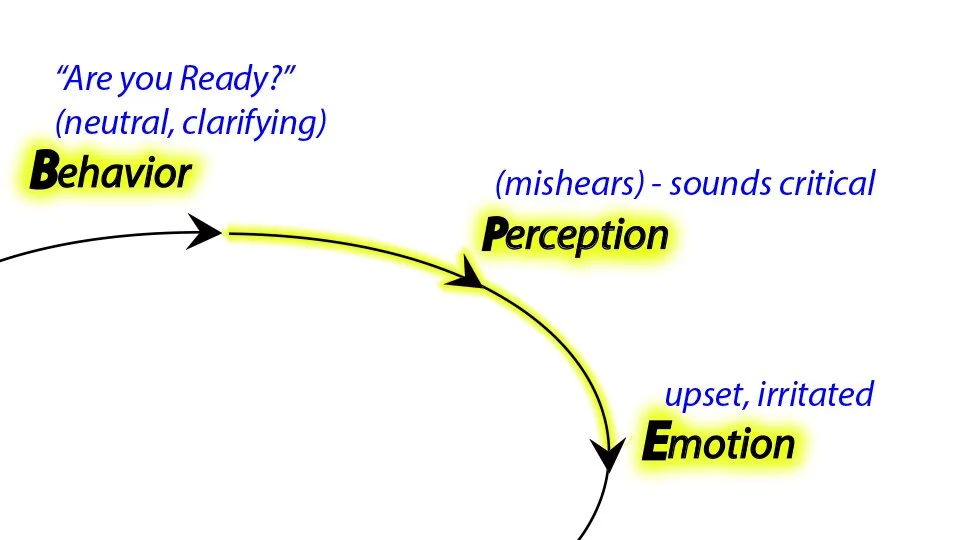Getting Back on Track
Getting your positive interactions back on track is key to maintaining a resilient relationship.
This tool is useful for misunderstandings and other simple kinds of interactions that have the potential to escalate and become problematic. Using this tool helps you two to stay resilient and work together to get back on track.
DERAILING:
At times, you might hear your partner say something s/he thinks is neutral that triggers you. If you misunderstand the message, you can feel upset.
Unfortunately, the easiest thing to do when you start to feel upset is to begin to blame your partner and become reactive. If you take the comment personally, you can get defensive, think badly about your partner, and react negatively.
Responding in that way is likely to lead to an escalation, especially if your partner was unaware of saying anything s/he thought you would take it badly. As s/he hears your response s/he could get hurt or angry and react in turn. If your partner fires back another reactive response you can find quickly find yourselves in an uncomfortable escalating pattern.
What’s important to know is that no matter who starts this kind of cycle, either of you can stop it. The tricky thing is: the person who feels the hurt first is the one who can stop the cycle most quickly.
Instructions: GETTING BACK ON TRACK:
Step 1: Remain Calm.
Your first job is to keep calm and take a breath. Your partner may not have meant to be hurtful. S/he may not have spoken thoughtfully or you might have misunderstood.
Step 2: Check Your Perception.
Once you take a breath, listen in your mind to what you just heard. You actually have an echoic memory that stores what you just heard for a few seconds (21). If you check it, you may find that you didn’t quite get the message right the first time. Remind yourself that this is a possibility and stay calm.
Step 3: Get curious.
If checking your perception still left you feeling upset or misunderstood, get curious about what was said, and check with interest and concern if you heard what your partner intended to say.
**Being curious instead of reacting keeps your emotions regulated and your “thinking brain” clear. This makes you less likely to take the comment personally or respond defensively, and it gives you a chance to check back with your partner to see if the message that he/she meant to send was the one that was received.
If your partner did speak harshly, your question will be a little wake-up call. They may now check their own echoic memory and perhaps realize that their comment didn’t come out very well. Then they might restate the message in a friendlier tone, using kinder words, or send a different message entirely.
In addition to handling misunderstandings and careless comments, Getting Back On Track is also a very helpful tool to use when you hear something you didn’t expect from your partner. Maybe it’s something you don’t agree with or you feel upset or offended by. If you haven’t become really practiced at resolving your differences, you may get agitated. You may worry that having different perspectives will make it hard to get along, or you may just get defensive and reactive. When that happens, you need to find a way to stay calm while seeing your partner’s point of view. Rather than responding with something like,
“That’s wrong!” or “I don’t THINK so!”
Show your concern in a more constructive way by saying,
“I didn’t see it that way, can you tell me more about how you see it?”
Like in the previous example, Calm and Curious are your allies. As you remain calm, you can check your Perception, inviting curiosity and openness into how you view your partner and what he or she just said. You are then regulating your emotions and can honor your partner’s differences by asking for more information, whether or not it’s something you agree with.
It takes effort and practice not to let your emotional brain take you over and escalate the situation with a reactive comment. We react to negative messages more frequently than positive messages, and as we’ve discussed already, we remember negative messages and events more than we do positive ones (22). Getting Back On Track allows you to shift from what could be a negative, escalating interaction, back into a positive feedback loop, helping to maintain your happy 5:1 ratio of positive to negative interactions.
Copyright Barbara B. White, Ph.D. 2012







